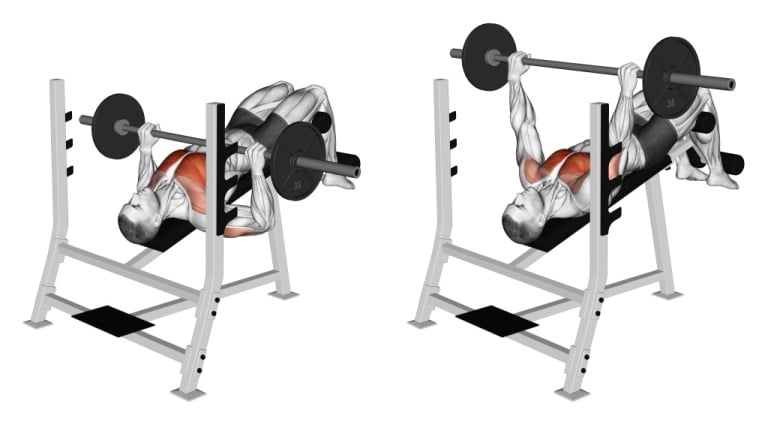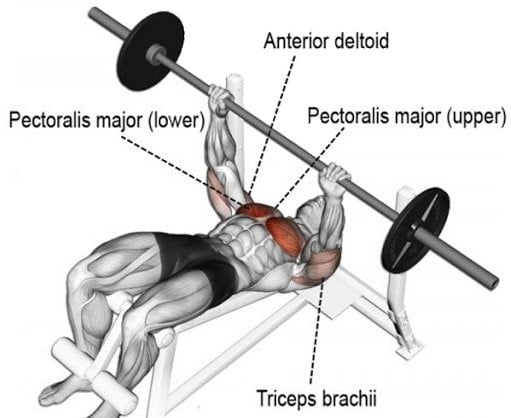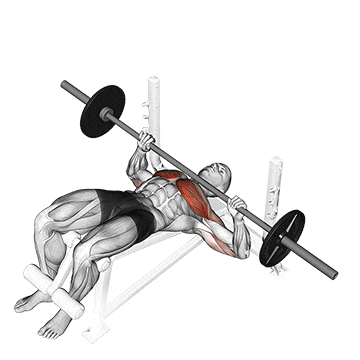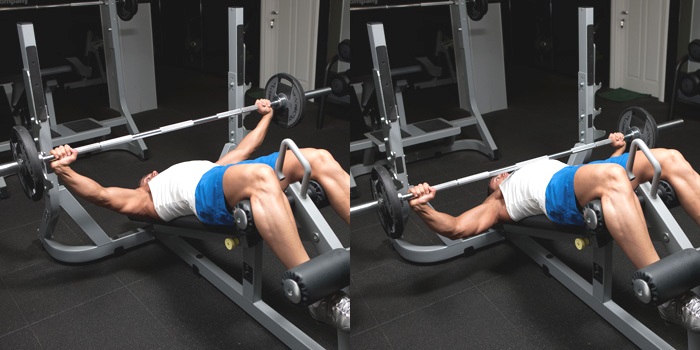If you want to build greater thickness and strength in your lower pecs, then you should add a decline barbell bench press to your training regime.
The decline bench press is an iconic move that builds serious chest strength and mass that can help you push past plateaus.
It is easy to learn and gets harder as you get stronger. This is why it’s used well in both beginners and advanced training programs.
This comprehensive guide will teach you everything you need to know about the decline barbell bench press and how to perform it correctly.
You will also learn its benefits, how to avoid common mistakes and the best variations of the decline barbell press.

- Chest Muscles (Anatomy)
- What Is The Decline Bench Press?
- Decline Barbell Chest Press Angle
- Decline Bench Press Muscles Worked
- How To Do Decline Barbell Bench Press
- 1. Set Up The Bench
- 2. Position Yourself
- 3. Lowering Motion
- 4. Pressing Motion
- Sets And Reps For Barbell Decline Press
- Sets
- Reps
- Decline Barbell Chest Press Proper Form And Mistakes
- Best Variations And Modification Of Decline Barbell Chest Press
- 1. Reverse Grip Decline Barbell Press
- 2. Wide Grip Decline Barbell Bench Press
- 3. Close Grip Decline Barbell Press
- Barbell Decline Press Benefits
- Frequently Asked Question
- What Is The Best Decline Bench Press Angle?
- Is Barbell Decline Press Necessary?
- Is Incline Or Decline Better For the Chest?
- Takeaways
- References
Chest Muscles (Anatomy)
The chest muscles primarily comprise the pectoralis major and pectoralis minor.
The pectoralis major is the large, fan-shaped muscle comprising the chest’s bulk. It has two functional subdivisions –the upper and lower regions.
- The upper region is referred to as the clavicular head because of its attachment to the clavicle.
- The lower regions are sometimes called the sternocostal head because of their attachment to the ribs.
Unlike the pectoralis major, the pectoralis minor isn’t visible but is crucial for functional strength and shoulder health. It is situated beneath the pectoralis major, which extends from the middle ribs to the shoulder region.

What Is The Decline Bench Press?
The decline barbell bench press is a variation of the traditional barbell bench press, where the bench is set to a declined position.
It’s an upper-body compound exercise that engages the lower pec muscles, the triceps, and the anterior deltoid muscles of the shoulders.
The angle of the adjustable bench in this variation puts more tension on your lower chest muscles than a flat bench press would.
The key benefits of the barbell decline bench press include enhanced lower chest stimulation, increased overall pectoral strength and size, and greater muscle damage to spur new growth.
It’s also important to correct the bench angle to hit the lower chest the most. Know the best angle.

Decline Barbell Chest Press Angle
Research indicates that the correct angle for the decline bench press should be 15–30 degrees, declining from flat to target the lower chest. Most standard decline benches offer adjustable angles in this range.
An angle of 15 degrees makes the flat bench press a little harder, but still allows you to lift heavy weights.
Conversely, a 30-degree decline results in an exaggerated bottom range of motion, thereby causing a significant stretch of the lower pectorals with lighter loads.
The sweet spot for most lifters is often right in the middle at 20–25 degrees. This makes the bottom part of your chest work harder without straining your shoulders too much when you lift heavier weights.
Try different angles from 15 to 30 degrees when you train, and find the best way to do a decline bench exercise. It depends on how your body works and how strong you are.
It may seem like a small angle, but it is the proper angle for training your lower pecs and minimizing the effect on the anterior deltoid muscles.
Want to take your gains to the next level? Discover your daily calorie needs with our free TDEE calculator.
Decline Bench Press Muscles Worked
The decline barbell bench press primarily works the major muscles of the lower pectoralis.
As this exercise is primarily used for the lower chest, it also places great stress on the inner and upper chest.
The barbell decline press involves several synergist muscles,
A handful of other muscles worked or play the role of stabilizer muscles, including your
- Biceps brachii,
- Brachialis,
- Triceps brachii,
- Wrist flexors

How To Do Decline Barbell Bench Press
Train the lower chest (sternal head) requires you to change the angle of your press to emphasize the lower part of the chest. You do this by either performing exercises on a decline bench.
1. Set Up The Bench
- Position an adjustable bench at a declined angle of around 15–30 degrees.
- Place the barbell on the rack above your eyes.
- Grip the barbell just outside shoulder-width with an overhand grip.
- Load the barbell with an appropriate weight.
2. Position Yourself
- Lie down on the bench with your feet secured under the leg support.
- Grab the barbell just outside the shoulder-width with an overhand grip.
3. Lowering Motion
- Inhale and slowly lower the barbell back down to the sides of your chest.
- Make sure to tuck the elbows rather than flaring them out.
- Repeat the desired number of reps.
4. Pressing Motion
- Exhale and press the weights to the starting position, feeling a good chest muscle contraction.
- At the top of the movement, the barbell should be directly above your chest, not your face.
- Your arms should be fully extended, but not locked.

Sets And Reps For Barbell Decline Press
Training volume refers to the total amount of work you perform during a workout, including the number of sets, reps, and weights used.
Of course, the number of sets and reps will be determined based on your fitness journey, but here is a great starting point.
Sets
According to the latest scientific evidence, 12–20 weekly sets per muscle group may optimize muscle growth.
- Beginners (with a year or less of training) should aim for about 12 weekly sets.
- An Intermediate trainee (with two to four years of training) can increase the volume to 16 sets per week.
- An advanced trainee (four or more years of training) may be able to get in up to 20 weekly sets.
When a certain amount of volume stops being effective and your progress stalls, you can add sets to increase volume and use that as a driver of renewed progress.
Reps
The best rep ranges and loads to work with.
- For muscle endurance: Aim for 15-20+ reps with moderate resistance.
- For muscle strength: 6–10 reps, with more resistance.
- For muscle hypertrophy (increased muscle size): Aim for 3–4 sets of 8–12 reps, with moderate to heavy resistance.
It’s best to start with fewer reps and sets at first, and then increase them as you get stronger.
To Stay Motivated: 150+ Gym Workout Motivational Quotes To Stay Fit
Decline Barbell Chest Press Proper Form And Mistakes
Proper exercise technique is essential to ensure the safety and effectiveness of an exercise program.
- Setting the bench at about 15–30 degrees is best for the decline barbell press.
- Keep the tension on your lower chest as you press the weight up.
- When you push the barbell up, make sure it should follow a straight line. This will increase your efficiency, and you could lift more weight.
- Always use the longest range of motion possible and control the barbells throughout the set.
- Keep your shoulder blades pinched together to ensure the shoulders remain safe.
- Ultimately, your results will depend on your ability to recover from your workouts adequately.
- It would be best to allow at least 36 to 48 hours of rest before training the same muscle groups again to allow for sufficient recovery.
- Ensure you maintain some tension in your abs, and don’t allow your lower back to have an excessive arch.
- It is also important that you focus on your breathing pattern. Proper inhaling and exhaling improves blood circulation and muscle recovery. So, make sure you breathe out when you push the weights up and breathe in when you bring them down to your chest.
Best Variations And Modification Of Decline Barbell Chest Press
The decline barbell bench press can be done differently to suit your fitness level.
If you are new to performing a decline barbell press, you may want to apply a few modifications to make the exercise easier. One way to counter this problem is to adjust the angle of the bench so that it is completely flat. Another is to use a lighter weight.
1. Reverse Grip Decline Barbell Press
The reverse grip decline barbell bench press is a variation of the decline bench press that targets the lower chest and triceps more effectively.
It’s an unconventional movement compared to the regular barbell press, where you grip the barbell with a reverse (supinated) grip.
Just be mindful of the decreased security an underhand grip provides—be sure to lift off and rerack the barbell with assistance from a spotter.

How To Do Decline Reverse-Grip Bench Press
- Set the decline bench to an angle of 15–30 degrees.
- Lie on the bench and grab the barbell with an underhand grip, slightly wider than shoulder-width apart.
- Unrack the barbell and slowly lower the barbell to your chest.
- Keep your elbows close to your body.
- Press the barbell back up to the starting position.
- Perform 3–4 sets of 8–12 reps.
2. Wide Grip Decline Barbell Bench Press
In the wide grip variation, your hands are placed farther apart on the barbell, typically wider than shoulder-width.
Compared to a narrower grip, the wider grip reduces the involvement of the triceps and shoulder and shifts more emphasis onto the outer chest muscles.
Keep in Mind:
- It can put additional strain on the shoulders.
- The wider grip typically reduces the range of motion.

How To Do Wide Grip Decline Barbell Bench Press
- Set the decline bench to a 15-30 degree angle.
- Secure your feet under the leg brace of the bench.
- Grab the barbell with a grip wider than shoulder-width apart.
- Lift the barbell off the rack and position it straight over your chest.
- Lower the barbell to touch your chest, and then push the barbell back up.
- Keep a slight bend in the elbows to maintain tension on the chest muscles.
3. Close Grip Decline Barbell Press
In the close grip version, your hands are placed closer together on the barbell, typically slightly narrower.
A close grip decline barbell bench press focuses more on the triceps and inner part of the chest.
This exercise is great for people who want to strengthen their triceps.

How To Do Close Grip Incline Barbell Press
- Grab the barbell with a grip that is narrower than shoulder-width apart.
- Pull your shoulder blades together and slightly stick out your chest.
- Lift the barbell off the rack and hold it straight over your chest.
- Breathe in and lower the barbell to chest level in a controlled motion.
- Press the weight back up when the bar touches your chest.
- Keep your elbows tucked in close to your sides as you lift. Please don’t allow them to flare out.
Barbell Decline Press Benefits
Several reasons motivate you to do decline the barbell bench press; I’ve mentioned some of them below.
- The exercise effectively targets the lower pectoral muscles, resulting in a well-rounded chest.
- Barbell decline press exercises require more balance than machines, which can lead to greater muscle fiber recruitment.
- It also engages the triceps and deltoids, contributing to overall upper-body strength.
- Puts less stress on the shoulder joints than flat and incline bench presses.
- It allows for greater joint safety and stabilization and allows the joints to move naturally within their range of motion.
- Barbell decline press variations allow for a greater range of movement (ROM), leading to increased muscle fibers recruited.
- It affords a greater variety, preventing physical and mental burnout.
Frequently Asked Question
What Is The Best Decline Bench Press Angle?
There is no one definitive angle you should use. The recommended angle range for the decline bench press is 15–30 degrees. It would be advisable to speak with your gym instructor to determine which would be the best for you.
Is Barbell Decline Press Necessary?
The decline barbell press is a great exercise and one of the most effective to target the lower pec of the chest. A well-developed lower pec gives the overall chest a well-defined and fuller look, so you can add this exercise to your workout program.
Is Incline Or Decline Better For the Chest?
For optimal chest development, all three varieties of bench press should be used: flat, incline, and decline.
Takeaways
The barbell decline chest press is highly recommended for anyone interested in building upper body strength and gaining muscle size.
It is easy to do and requires no more scientific details and fancy equipment.
You will see results if you consistently do decline chest press exercises with other chest press variations.
References
- Saeterbakken, A. H., et al. (2017). The effects of bench press variations in competitive athletes on muscle activity and performance.
- Influence of bench angle on upper extremity muscular activation during bench press exercise. Lauver, J. D., Cayot, T. E., & Scheuermann, B. W. (2015). European Journal of Sport Science, 16(3), 309-316. doi:10.1080/17461391.2015.1022605. URL: https://www.tandfonline.com/doi/full/10.1080/17461391.2015.1022605, accessed on 24.08.2020
- An Electromyography Analysis of 3 Muscles Surrounding the Shoulder Joint During the Performance of a Chest Press Exercise at Several Angles. Trebs, A. A., Brandenburg, J. P., & Pitney, W. A. (2010). Journal of Strength and Conditioning Research, 24(7), 1925-1930. doi:10.1519/jsc.0b013e3181ddfae7
- Lauver JD, Cayot TE, Scheuermann BW. Influence of bench angle on upper extremity muscular activation during bench press exercise. Eur J Sport Sci. 2016;16(3):309-16. doi: 10.1080/17461391.2015.1022605. Epub 2015 Mar 23. PMID: 25799093.

Manish brings over 10 years of hands-on experience in weight lifting and fat loss to fitness coaching. He specializes in gym-based training and has a lot of knowledge about exercise, lifting technique, biomechanics, and more.
Through “Fit Life Regime,” he generously shares the insights he’s gained over a decade in the field. His goal is to equip others with the knowledge to start their own fitness journey.
